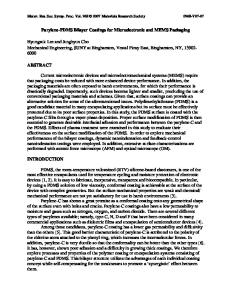Sol-Gel Processing of Glasses and Glass-Ceramics for Microelectronic Packaging
- PDF / 604,341 Bytes
- 9 Pages / 420.48 x 639 pts Page_size
- 103 Downloads / 304 Views
SOL-GEL PROCESSING OF GLASSES AND GLASS-CERAMICS FOR MICROELECTRONIC PACKAGING M.A. Sriram and P.N. Kumta, Department of Metallurgical Engineering and Materials Science, Carnegie Mellon University, Pittsburgh, PA-15213.
S............................................................................................................
In recent years considerable progress has been made in electronic packaging substrate technology. The future need of miniaturization of devices to increase the signal processing speeds calls for an increase in the device density requiring the substrates to be designed for better thermal, mechanical and electrical efficiency.Fast signal propagation with minimum delay requires the substrate to possess very low dielectric constant. Several glasses and glass-ceramic materials have been identified over the years which show good promise as candidate substrate materials. Among these borophosphate and borophosphosilicate glass-ceramics have been recently identified to have the lowest dielectric constant (3.8). Sol-gel processing has been used to synthesize borosilicate, borophosphosilicate and borophosphate glasses and glass-ceramics using inexpensive boron oxide and phosphorus pentoxide precursors. Preliminary results of the processing of these gels and the effect of volatility of boron alkoxide and its modification on the gel structure are described. X-ray diffraction, Differential thermal analyses and FTIR have been used to characterize the as-prepared and heat treated gels.
1.Introd~uctions The advancement and miniaturization of integrated circuits has made microelectronic packaging an integral part of device technology. The past four decades has witnessed a phenomenal growth and progress in semiconductor device technology that has placed stringent requirements on microelectronic packaging especially in the area of electronic substrates. The substrates need to possess good mechanical, thermal and electrical properties in order to satisfy the strength, heat dissipation and fast signal propagation criteria. Ceramic packaging is one of the most active areas in packaging and the role of ceramic materials as substrates in several packages such as dual-in-line packages, chip carriers, and pin grid arrays is well known[I-6]. Ceramics have dielectric constants from 4 to 10,000, thermal expansion coefficients matching 7 silicon (30x10- /oC), and a range of thermal conductivities making them one of the best materials for insulation to heat conduction better than aluminum metal. Table 1 lists the relevant properties of these materials for packaging applications[ 1,7]. Glass-ceramics with their dielectric constant around 5 and their excellent thermal expansion match with silicon coupled with the ability to co-sinter with copper, or gold make them potentially one of the best candidate materials for high-performance multilayer ceramic substrates. In addition, their surface properties make thin film metallization and deposition of dielectric materials very easy making them an excellent choice for high perfo
Data Loading...










